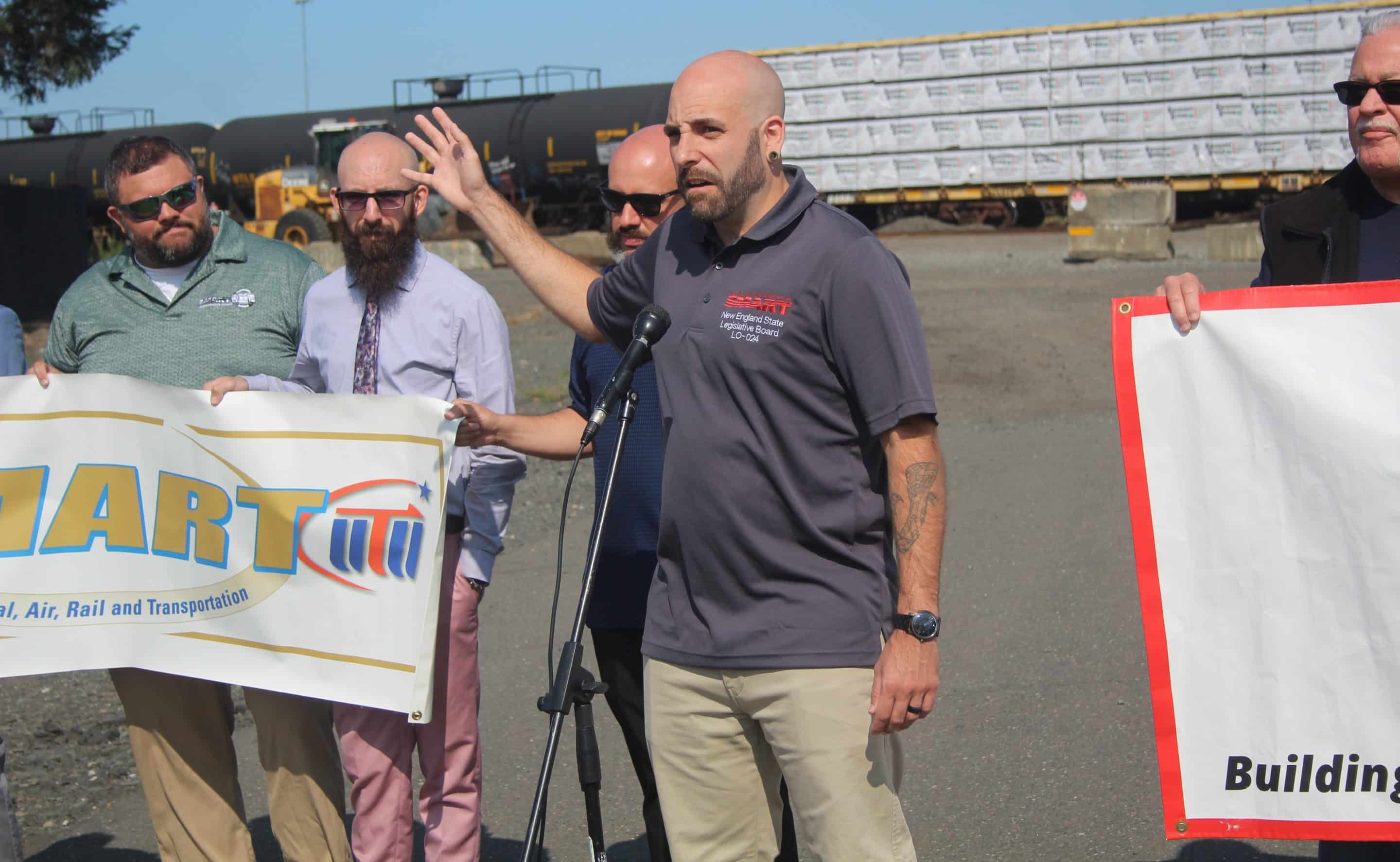Christopher Tyrrell, from the SMART Local 352 transportation workers union, advocates for safety improvements at the Memorial Avenue train crossing at a press conference Sept. 12, joined by other labor leaders.
Reminder Publishing photo by Tyler Lederer
WEST SPRINGFIELD — Mere feet away from the Big E’s busy Gate 9, train conductors use a railroad crossing to transport 33,000 gallons of propane from West Springfield’s CSX yard to NGL Supply, behind Memorial Avenue’s shopping centers.
It’s easy to miss, only marked by a sign and warning lights, with no gates to stop traffic on the four-lane thoroughfare. Train engineers have to walk into the street and light flares to make sure drivers see that a train is crossing, often at night. Still, drivers fly through the crossing, posing a safety hazard to workers and themselves, said Christopher Tyrrell, train engineer and assistant legislative director for the SMART Local 352 transportation workers union.
“I have numerous testimonials and accounts of people blowing through the crossings, people nearly hitting the conductors and not stopping for the railcars,” he said, before a Sept. 12 press conference highlighting the issue.

Reminder Publishing photo by Tyler Lederer
To get across, conductors have to stop just short of the crossing, manually turn on the warning lights, go into the middle of a street with a 50 mph speed limit, manually drop road flares on either side of the crossing, then bring the propane tanks across.
Tyrrell said it’s especially bad during the Big E, where conductors have to push through the traffic to get their job done.
Mat Pietrzak, president of SMART Local 352, said he’s experienced multiple close calls himself. In one case, a driver ran over a conductor’s foot, he said.
Besides the danger for conductors, danger exists for West Springfield residents, too. The propane tankers are black, and tend to be shipped at night. Should a car hit them, a catastrophic explosion would follow.
“However many [tanker] cars you have together, you’re probably going to have some sort of chain reaction and could have everything explode. Serious fire,” Pietrzak said.
Asked if drivers didn’t seem to know or understand how dangerous this shipment is, Pietrzak said, “100%.”
“They’re too busy,” he said. “They don’t want to stop. They don’t want to wait for a train. We have the same issue up at Front Street. That actually has crossing gates and arms and all that other stuff, and people still go through that crossing.”
At a press conference, Tyrrell emphasized the need for crossing gates. He also called for more lights, and circuits that activate the gates automatically when a train approaches.
“Please advocate to your local city councilor, to the mayor, to push to get the gates put in, to protect everyone that’s involved on a daily basis,” he said.
Tyrrell was joined by Jeff Jones, president of the Western Massachusetts Area Labor Federation, and Kevin Brousseau, secretary-treasurer of the Massachusetts AFL-CIO, both of whom stood in solidarity with the transportation workers union.
“Advocacy for safety precautions at this crossing is advocacy for safer streets,” said Brousseau. “These men and women are fighting for safer streets, while fighting for safety on the job, and we’re here to stand with them every single day until we get results right here at this crossing.”
Jones said he did not want to see anything happen here similar to the 2023 train derailment in East Palestine, Ohio. That derailment led to a chemical spill contaminating the soil and water. Cleanup is still ongoing.
“I applaud the support that we have thus far, but we want to get this done ASAP before something more tragic happens,” he said.
The unions hosted the press conference in anticipation of a Sept. 25 diagnostic session by the state Department of Public Utilities, which will determine if any upgrades to the crossing are needed.
The problem is that an upgrade involves first determining who owns the crossing.
“We’ve complained to [CSX] numerous times that we would like crossing gates here and we’ve yet to see it done. We’re talking years,” Tyrrell said, adding that he had to escalate the problem to the state level.
A CSX spokesperson told Reminder Publishing that improvements to crossing equipment would have to come from the state, not the railroad company, with the decision to implement them being the responsibility of “the highway authority” and the state Department of Transportation.
The spokesperson also said safety was a top priority of the railroad company, which is why conductors use flares at the crossing.
Town Engineer Connor Knightly said the Eastern States Exposition commissioned the crossing in the early 1900s with what was the local rail company at the time. Both agreed that a third party would be responsible for the maintenance.
That third party is not the town, which he said doesn’t own the crossing, only the right of way between the Morgan-Sullivan Bridge to Agawam and the Memorial Bridge to Springfield.
“The town maintains that we own the right of way, but the physical rails themselves are owned not by the town, but the third party,” he said. “The controversy is which third party is responsible: the customers that utilize deliveries from the spur crossing, or CSX themselves.”
While a contractor can build crossing gates, someone has to take ownership of them afterward, and thus take responsibility for their maintenance. There is no Western Massachusetts rail authority, like the MBTA in eastern Massachusetts, that could take ownership of it in place of other involved parties, Knightly said.
No ownership means no chance of them being built.
“There’s a chance that it could be a low-cost operation,” he said. “There’s a chance that it could be a high-cost operation. It does come with responsibilities, and that’s something that all related parties don’t want to encumber.”
Tyrrell hopes that something can be done soon.
“It’s like watching paint dry,” he said. “Hopefully with the help that I have now, this can be achieved rather quickly.”


